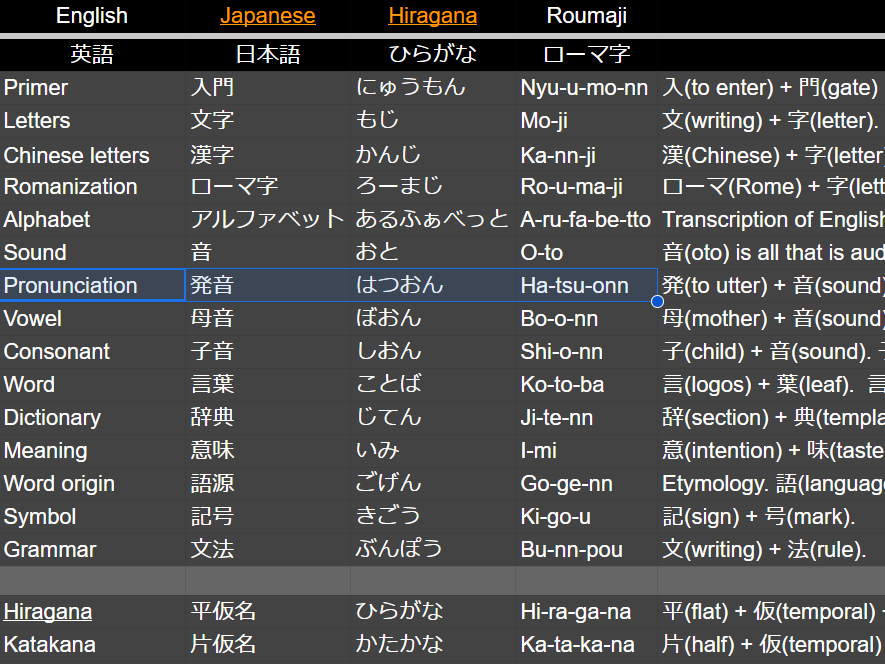Data 日本語入門 Primer to Japanese Language

Data 日本語入門 Primer to Japanese Language
教材 Material:
日本語入門 Primer to Japanese Language Level 1 Data
解説 Commentary:
入門 (Hiragana: にゅうもん Romaji: Nyu-u-mo-nn) means a primer in Japanese.This page lists basic words that Japanese language learners need to get started.
このページは、日本語学習者が、入門に必要な基本単語を、整理します。
入門. にゅうもん. Nyu-u-mo-nn. Primer.
入(to enter) + 門(gate).
文字. もじ. Mo-ji. Letters.
文(writing) + 字(letter).
文字(Moji) is the general word for characters.
文字は、広く文字を表す言葉です。
漢字. かんじ. Ka-nn-ji. Chinese letters.
漢(Chinese) + 字(letter).
Japanese high school students can read 2000 漢字(kannji) characters by the time they graduate.
日本の高校生は、卒業時に、2000字の漢字が、読めます。
ローマ字. ろーまじ. Ro-u-ma-ji. Romanization.
ローマ(Rome) + 字(letter).
ローマ字(roumaji) is another word for Alphabet.
ローマ字は、アルファベットの別名です。
The Japanese say "ローマ字で書く" when write Japanese word in Alphabet.
日本語をアルファベットで書く時に、日本人は「ローマ字で書く」と言います。
アルファベット. あるふぁべっと. A-ru-fa-be-tto. Alphabet.
Transcription of English "Alphabet."
英語「Alphabet」の音訳です。
Always write in Katakana.
いつもカタカナで書きます。
音. おと. O-to. Sound.
音(oto) is all that is audible to the ear.
音は、耳に聞こえるすべての音です。
発音. はつおん. Ha-tsu-onn. Pronunciation.
発(to utter) + 音(sound).
発音 is the sound that comes out of the human mouth.
発音(hatsuonn)は、人間の口から出る音です。
母音. ぼおん. Bo-o-nn. Vowel.
母(mother) + 音(sound).
The Japanese language has five "あいうえお(aiueo)" 母音(bo-onn).
日本語は「あいうえお」の五個の母音があります。
子音. しおん. Shi-o-nn. Consonant.
子(child) + 音(sound).
子音(shi-onn) are all sounds except 母音(bo-onn).
子音は、母音以外のすべての音です。
言葉. ことば. Ko-to-ba. Word.
言(logos) + 葉(leaf).
言葉(kotoba) derives from the Japanese archipelago.
言葉は日本列島由来です。
The modern Japanese language includes both "漢語(かんご kann-go)" derived from China and "和語(わご Wa-go)" derived from the Japanese archipelago.
現代日本語は、中国語由来の漢語と、日本列島由来の和語を、含みます。
辞典. じてん. Ji-te-nn. Dictionary.
辞(section) + 典(template).
意味. いみ. I-mi. Meaning.
意(intention) + 味(taste).
語源. ごげん. Go-ge-nn. Word origin. Etymology.
語(language) + 源(origin).
記号. きごう. Ki-go-u. Symbol.
記(sign) + 号(mark).
文法. ぶんぽう. Bu-nn-pou. Grammar.
文(writing) + 法(rule).
平仮名. ひらがな. Hi-ra-ga-na. Hiragana.
平(flat) + 仮(temporal) + 名(name).
平仮名(ひらがな hiragana) is a script developed in the Japanese archipelago from Kanji.
平仮名は、漢字を起源として、日本列島で開発した文字です。
One character represents one sound.
一文字が一音を表します。
片仮名. かたかな. Ka-ta-ka-na. Katakana.
片(half) + 仮(temporal) + 名(name).
片仮名(Katakana) and 平仮名(hiragana) correspond one-to-one.
片仮名と平仮名は、一対一で、対応します。
"アイウエオ" and "あいうえお" have a one-to-one correspondence.
「アイウエオ」と「あいうえお」は一対一で、対応します。
片仮名 (katakana) is used to make sentences easier to read, similar to English uppercase and lowercase letters.
片仮名(カタカナ)は、英語の大文字と小文字と同様に、文章を読みやすくするために使います。
五十音. ごじゅうおん. Go-ju-u-o-nn. Fifty sounds.
五(five) + 十(ten) + 音(sound).
五十音(gojuu-onn) is another name for 平仮名(ひらがな hira-gana). 五十音は、平仮名の別名です。
平音. へいおん. He-i-o-nn. Flat sounds.
平(flat) + 音(sound).
平音(hei-onn) is from "あいうえお(a-i-u-e-o)" to "わをん(wa-wo-nn)" in 平仮名(ひらがな hiragana).
平音は、平仮名のうち、「あいうえお」から「わをん」まで。
The throat does not vibrate when pronouncing 平音(hei-onn).
平音を発音する時は、喉が振動しません。
濁音. だくおん. Da-ku-o-nn. Muddy sounds.
濁(muddy) + 音(sound).
濁音(daku-onn) are from "がぎぐげご(ga-gi-gu-ge-go)" to "ばびぶべぼ(ba-bi-bu-be-bo)" in 平仮名(ひらがな hiragana).
濁音は、平仮名のうち、「がぎぐげご」から「ばびぶべぼ」まで。
The throat vibrates when pronouncing 濁音(daku-onn).
濁音を発音する時は、喉が振動します。
拗音. ようおん. Yo-u-o-nn. Twisted sounds.
拗(to twist) + 音(sound).
拗音(you-onn) is pronunciation in 平仮名(ひらがな hiragana) with a small "ya-yu-yo".
拗音は、平仮名のうち、小さな「やゆよ」を付ける発音です。
あいうえお. あいうえお. A-i-u-e-o.
In Japanese, "あいうえお(a-i-u-e-o)" is the first five letters of 平仮名(ひらがな hiragana).
日本語の「あいうえお」は、平仮名の最初の五文字です。
In Japanese, primary school students learn "A-i-ue-o" first.
日本語では、小学生はまず「あいうえお」を、学習します。
仮名. かな. Ka-na. Alias.
仮(temporal) + 名(name).
仮名 (ka-na) is a whole set of 平仮名(ひらがな hiragana) and 片仮名(Katakana).
仮名は、平仮名(ひらがな)と片仮名(カタカナ)を、一式まとめたものです。
振仮名. ふりがな. Hu-ri-ga-na. Hiragana aid.
振(to swing) + 仮(temporal) + 名(name).
振仮名 (ふりがな fu-ri-ga-na) is reading aid in Hiragana.
振仮名(ふりがな)は、ひらがなで、読書を助けます。
When students don't know the reading of a kanji, teachers put 振仮名 (ふりがな fu-ri-ga-na) aside of the kanji.
生徒が漢字の読みを知らないとき、教師は、その漢字の脇に、振仮名(ふりがな)を、置きます。
Textbooks for begginners are with 振仮名 (ふりがな fu-ri-ga-na).
初級者向けの教科書は、振仮名(ふりがな)が、付いています。
ルビ. るび. Ru-bi. Hiragana aid. ルビ (るび ru-bi) is the another name for 振仮名 (ふりがな fu-ri-ga-na). ルビは、振仮名の別名です。
真名. まな. Ma-na. True name. Official name.
真(true) + 名(name).
声. こえ. Ko-e. Voice.
連濁. れんだく. Re-nn-da-ku. Euphony.
連(liaison) + 濁(muddy).
音読み. おんよみ. O-nn-yo-mi. Chinese-reading.
音(sound) + 読(to read) + み.
音読み (おんよみ o-nn-yo-mi) is a way of reading kanji imported from China.
音読みは、中国から輸入した漢字の読み方です。
It is similar to the Chinese pronunciation.
中国語の発音に、似ています。
訓読み. くんよみ. Ku-nn-yo-mi. Japanese-reading.
訓(meaning) + 読(to read) + み.
訓読み (くんよみ k-u-nn-yo-mi) is a way of reading Kanji based on the words derived from Japanese archipelago.
訓読みは、日本列島由来の言葉に基づく漢字の読み方です。
This site shows the basic words to start learning Japanese and East Asian languages.
このサイトは、日本語や東アジア言語を学び始めるための、基本単語を、紹介します。
探求資料 Further study:
Japan Ministry of Education (文部科学省). 学習指導要領 生きる力. 2017.
Republic of Korea Ministry of Education (대한민국 교육부).
People's Republic of China Ministry of Education (中华人民共和国教育部). Tōngyòng Guīfàn Hànzì Biǎo (通用规范汉字表). 2013.
U.S. Department of Education (アメリカ合衆国教育省).

Post my Q and A